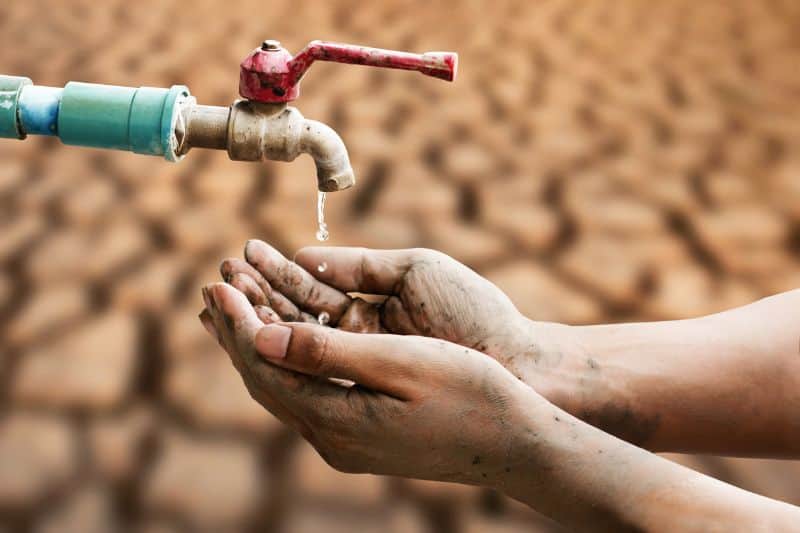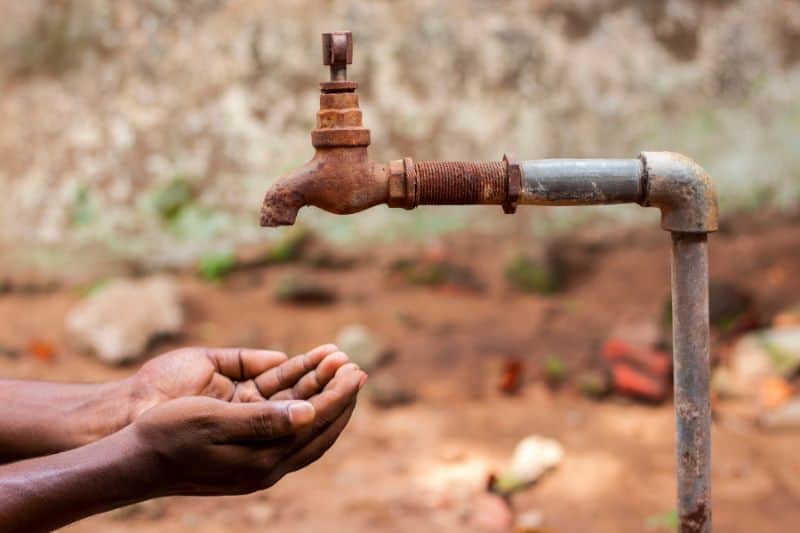Did you know that only 2.5% of all the water in the world is freshwater? Even more surprising, only about 0.5% of the world’s freshwater is accessible.
By accessible, I mean water that’s actually available for our use, as most of the freshwater remains trapped in glaciers and snowfields. That’s a small percentage, especially considering that our planet has about 8 billion people.
In fact, it’s too small that about 1.8 billion people every year are faced with a lack of clean water, resulting in a water crisis.
A water crisis is when there is not enough potable water for a population. This situation eventually leads to drought, famine, and death. Today, safe drinking water has become a luxury for people living in drought-hit regions and the African subcontinent.
People can be seen walking miles and spending the entire day searching for it. Even more sad, once they get it, they again have to fight with the waterborne diseases arising from it.
Economic development suffers when basic necessities are unmet, and people must struggle hard for them. Still, we people take it for granted and do not understand the importance of water conservation. Today, we will review some causes, effects, and possible solutions for the water crisis.
Clean water and access to food are some of the simplest things that we can take for granted each and every day. In places like Africa, these can be some of the hardest resources to attain if you live in a rural area.
~ Marcus Samuelsson
Major Causes of Water Crisis
Water crisis can be attributed to several factors, including:
1. Water Pollution

Most water sources in rural areas are terribly polluted due to poor sanitation and a lack of waste treatment plants. Overall levels of global pollutants are having a negative effect on the drinking water that is currently clean. And as time goes on, this damage will be exacerbated.
2. Groundwater Over Drafting
Excessive groundwater use in our agricultural industries leads to diminished yields and wasted water. Over 70% of our water is used to grow crops, and most of it is wasted due to leaky pipes and poor watering techniques.
3. Overuse and Misuse of Water
Improper use of available water leads to more water being wasted and squandered for pointless reasons and further escalations of the crisis. One single hamburger takes 630 gallons of water to produce!
4. Disease
A large quantity of the available groundwater in the worst affected parts of the world is ridden with disease due to the lack of proper water treatment and recycling.
5. Climate Change
Climate change is changing how water evaporates and where it rains, pushing rainfall further south in both hemispheres. Global warming has altered the rainfall pattern in India dramatically. Previously, average monsoon rainfall spanned 45 days. This number has now decreased to 22 days, with each monsoon having a smaller intensity of rain.
6. Mismanagement
Improper training and education lead to a needless waste of safe, clean water every day and overuse in areas that don’t require so much of it. A good example of a country lacking proper water management policies is India.
Despite being a populous country with a diverse geography and climate, India does not have a comprehensive water policy. There are no proper guidelines available for the usage of surface water and groundwater by different sectors and different states.
7. Human Settlements
Construction of dams, other hydroelectric projects, and water diversion for irrigation have led to the systematic destruction of large river ecosystems.
8. Corruption

Simply put. Some people who have the power to help those in need just don’t care.
9. Lack of Institutions
Lesser developed countries have no institutions to advise on water treatment and management; this leads to mismanagement and waste
10. Lack of Infrastructure
Poor regions often don’t have the funds or education to implement proper infrastructures such as waste treatment and recycling plants
11. Loss of Groundwater
Due to climate change, human expansion and development are leading to the loss of groundwater worldwide.
12. Groundwater Exploitation
In addition to irrigation, groundwater exploitation has resulted from rapid urbanization and extreme groundwater usage by soft drink companies such as Coca-Cola.
India uses more groundwater than any other country in the world, and groundwater exploitation has caused accelerated drying of aquifers. The total groundwater used for irrigation has risen from 30% in the 1980s to nearly 60% today.
13. Unutilized Resources
River basins, catchments, and watersheds have not been properly utilized for water and soil conservation purposes, affecting the river basins’ hydrology.
14. Unfair pricing of water
Areas of extreme poverty often have to pay exorbitant rates to purchase clean water. Those without money are forced to drink from holes in the dirt or puddles on the roadside.
Effects of Water Crisis
Below are the effects of the water crisis on us.
1. Death
All life needs water; every 90 seconds, a child dies from water-related illness and disease.
2. Disease
Waterborne disease is one of the leading causes of mortality in the world; water-related disease affects more than 1.5 billion people yearly.
3. Warfare
Regional conflicts have arisen due to the loss of safe water sources.
4. Lack of Irrigation
Without water, farmers can’t grow any crops, which leads to the death of nearly 1 million people every year.
5. Lack of Sanitation
This leads to disease and causes countless health issues.
6. Lack of Hygiene

1/3 of the world’s population lives without access to a toilet. This leads to disease and kills nearly 1 million people each year.
7. Agricultural Problems
No water means no crops. Previous regions with a good amount of water have seen a decline in the groundwater, and without water, they cannot grow crops.
8. Livestock Problems
The lack of water makes it impossible to keep livestock, making it even harder for people in arid regions to find food and income.
9. Malnutrition
Due to lack of water and the ability to grow crops, malnutrition increases the chance of disease and death. 160 million children suffer from chronic malnutrition linked to water and sanitation.
10. Birth Defects
Lack of nutrition during pregnancy and malnutrition causes birth defects in infants.
11. Poor Education
Most schools in the worst affected areas do not have a toilet or safe drinking water for students, which leaves students dehydrated and mentally incapable of achieving well in school.
12. Poor Healthcare
Most hospitals and clinics operate without access to safe water, leaving them unable to help people safely.
13. Societal impact
Improvements in society are halted due to a constant need to find water. On average, 5-6 hours daily are spent looking for water. Collectively, women and children spend 125 million hours every day collecting water.
Economic Effects of Water Crisis
Of course, water crisis doesn’t come without economic effects.
Some of them include:
1. Wasted Time
Roughly $24 billion worth of time is wasted each year gathering water.
2. Loss of Funds
Ending the water crisis would result in $32 billion in benefits by reducing healthcare costs and increasing productivity.
3. Cost of Death
Ending the water crisis would result in 18.5 billion dollars from deaths avoided.
Effects of Water Crisis on the Environment
The environmental impact of water crisis includes but is not limited to the following:
1. Increased Salinity
It is mainly due to the poor treatment of water and sanitation. This leads to more water being unsafe to drink.
2. Nutrient Pollution
Algal growth caused by excessive nutrients in groundwater is rendering more water unsafe to drink due to high nitrate levels.
3. Loss of Floodplains
Due to human expansion, it leads to the drying of riverbeds and loss of habitat.
4. Drying of Riverbeds
It is primarily due to poor agricultural practices and human expansion. This leads to loss of habitat and less water access for poor regions.
5. Loss of Habitat
It leads to the extinction of species that rely on water to survive in arid climates.
6. Subsidence
It is caused by the loss of groundwater and leads to landslips and sinkholes.
7. Wetlands Disappearing
Since 1900, about half of the world’s wetlands have been destroyed. Wetlands support some of the most productive habitats on the planet, high concentrations of animals, including mammals, birds, fish, and invertebrates, and serve as nurseries for many of these species.
Wetlands also support rice cultivation, a staple food of half the world’s population. They also provide various ecosystem services that benefit humanity, including water filtration, storm protection, flood control, and recreation.
8. Ecosystem Loss
Water scarcity affects natural landscapes badly. The Aral Sea in central Asia, once the world’s fourth-largest freshwater lake, lost an area the size of Lake Michigan in just three decades. It is now as salty as an ocean due to the excessive pollution and the diversion of water for irrigation and power generation.
As the sea has retracted, it has left polluted land. This ecological catastrophe has not only created food shortages but resulted in a rise in infant mortality and a decrease in life expectancy for the nearby population.
Solutions to Water Crisis
Thankfully, even with all the negative impacts attached to water crisis, several ways can be taken to reduce the crisis:
1. Charities
Donating to a charity will help in a small way; charities help people in rural areas access water by constructing wells, sanitation, and agricultural systems.
2. Funding
Governments could allocate more funding toward ending the water crisis. Currently, the US government donates $8 billion every year, and $1 Trillion is needed to solve the problem in the long term.
3. Spreading the Message

Educate people better on the causes and effects of the water crisis and what they can do to help. So, they, in turn, can teach others and raise awareness.
4. New Technologies
Incentivize innovation in the fields of water recycling, conservation, and consumption.
5. Improved Irrigation
Change the way we irrigate. Roughly 70% of the world’s freshwater is used to grow crops. We could improve these practices to use much less water than we currently use.
Employing agricultural practices such as planting crops that require less water, setting up irrigation systems without leakages, and developing farm-based water conservation structures is very important. This can aid in the protection of forests and the development of horticulture.
6. Water Pricing
Research the true effects of water pricing. Experts are currently debating increasing the price of water to reduce pollution, but that would take water even further out of reach by those experiencing poverty.
7. Energy-efficient Desalination Plants
We must start finding ways to make the current desalination plants more effective. By reducing the energy required to run these plants, we will help millions of people worldwide.
8. Rainwater Harvesting
Areas with very few groundwater reserves can greatly improve how they harvest rainwater by building larger facilities and incorporating better technologies.
9. Address Pollution
As a species, we need to address the ever-growing challenge of pollution. Enough studies have been done; it’s time to take action quickly to save billions of lives.
10. Population Growth Control
Until we solve the water crisis, limiting the population’s expansion may be beneficial. This will lead to more accurate predictions of water needed for the next 100 years.
11. Climate Change

Experts say that decreasing the effects of global warming by pursuing cleaner energies will, in turn, help with the water crises as we find new technologies to keep water safe and use less energy to do so.
12. Transfer of Technologies
More developed countries with a higher level of technological advancement can help greatly by sharing their advancement with developing countries.
13. Awareness
Increased awareness of citizens, particularly in urban areas, is crucial. Solving this crisis means that each citizen must be aware of the crisis and participate in proper conservation, stopping water misuse, and eliminating bottled water usage.
14. Water Conservation
Water conservation is absolutely necessary at the community level to reduce groundwater pressure and supply water for human consumption. Thus, developing community-level water harvesting structures like water bodies is important.
15. Initiative of Statutory Bodies
Local governments can participate in water conversation by utilizing watershed development and monitoring groundwater usage by farmers. It is important to encourage farmers at the district and state levels to choose crops wisely, help harvest water using watersheds, and provide necessary mechanisms for protecting and conserving water bodies/ ponds, forests, groundwater, rivers, and streams.
16. Water Policy
Developing formal water policy at the center and state level is crucial. This will guide the administration and citizens in properly using surface water and groundwater. It is also necessary to create management strategies for interstate and transboundary Rivers.






